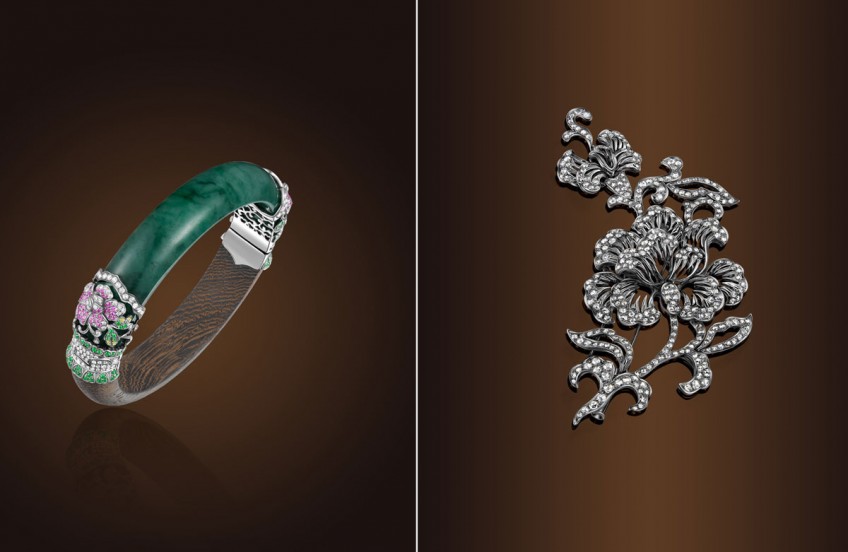Qing bling

Those lucky enough to be in the Big Apple this summer could still make it to the wildly popular Metropolitan Museum of Art's Costume Institute exhibition, "China: Through The Looking Glass" exhibition. With a run extended till Sept 7, the eighth most popular exhibit ever at the museum comprises 150 dresses, gowns and costumes from 40 designers influenced by the beauty and artistry of China - from the chinoiserie concoctions of Paul Poiret and Yves Saint Laurent, a Gladwrap-tight cheongsam by John Galliano, to jewels by Cartier, Van Cleef & Arpels and Bulgari.
But get this, the many rarefied pieces painstakingly curated for the blockbuster were all created by western designers. So it's about time that the imagination of Asian stylemeisters is similarly fuelled by the aesthetics, craftsmanship and history of the Middle Kingdom. And for Hong Kong jewellery designer Dickson Yewn, Chinese culture is the only influence he needs in his 15-year career.
"There is a rich 5,000-year history from which I can be inspired, but no one else seems to be wholeheartedly doing contemporary Chinese jewellery design at the forefront of luxury - funny, no?" says the 45-year-old creator of jewellery, who will be hosting a private showcase here this month. "Why do people nowadays create jewellery with only or mostly western influences? Don't they get even more bored?"
The design veteran, a graduate from the Fashion Institute of Technology in New York, is certainly enthusiastic about mining references from Chinese history. In fact, he has spent the past five years drawing inspiration from Chinese literature for his new collection, particularly the Taoist story Chuang Tzu Becomes a Butterfly. In it, the Taoist master awakes from a dream that he was a butterfly, and wonders if he were a man dreaming that he was a butterfly, or a butterfly dreaming he were a man.
The representation of butterflies in contemporary jewellery design is often rigid and unnatural, according to Mr Yewn, being overly adorned with expensive stones and heavy materials. The jewellery designs in his Dream and Reality collection, however, attempt to replicate the true nature of the species and reflect the intricacies of its inspiration.
"Five years is an unusually long time to complete a collection," admits Mr Yewn. "Six months to a year is more realistic. The reason why I took such a long time is partly artistic and partly commercial. The artistic side is for me to source enough species of wood to pair with the butterfly designs; the commercial side is my need to save enough money to venture into such a non-commercial venture of creating butterflies with not too many precious stones to best represent real butterflies."
In the past, Mr Yewn's works have been inspired by ornate jewellery worn by the royalty of Imperial China and even traditional Chinese paper-cuttings.
Using traditional stones like jadeite, pearl, tourmaline, coral and ruby, he tapped on the designs of historical hair pieces, bangles, rings and earrings as the starting point of his Imperial Grace collection - pairing the gems with gold settings specially treated to produce an antique finish.
"Most techniques found in the western jewellery world were widely available in China hundreds of year before Christ," explains Mr Yewn. "Many things perceived as 'western' nowadays came a long way from India, China and Islamic worlds. But the task of reviving imperial jewellery-making techniques is like bringing a gene pool of Chinese antelopes back from Europe to China (where many aboriginal species are now extinct, but could be found in Europe)."
Despite the challenges of utilising traditional methods in producing his pieces, the majority of Mr Yewn's pieces are made in China by local artisans under the helm of Hong Kong and French workshop managers.
"Chinese hands are the most magical in the world," declares Mr Yewn.
"Given proper motivation and fair remuneration, they can all become the same hands that made Imperial China the best and biggest exporter of fine luxury goods in the world for more than 1,500 years, but which sadly and rapidly declined after 1911 (the year that the Chinese Revolution overthrew the Qing Dynasty and ended the imperial system)."
To complement his new 60-piece jewellery collection, each a representation of an actual butterfly species, Mr Yewn also plans to set up a contemporary Chinese literati space to showcase tea, wood sculptures and contemporary Chinese furniture - a renaissance space of sorts for Chinese culture.
"Sadly, many Chinese clients of mine lost their cultural roots in this globalised world," laments Mr Yewn. "They actually bought my works purely out of our brand's popularity in certain elitist circles in the west, among western clients who could boast of 'old money' and grew up in castles and were surrounded by Chinese antique porcelain."
As ironic as that may be, at least the Chinese purist is able to communicate the innovations and virtuosity of his heritage to a new audience, filtered through the facets of luxury bling.
Besides, what better way to trigger a discourse about Taoist philosophy than donning a breathtaking bauble?

This article was first published on July 4, 2015.
Get The Business Times for more stories.